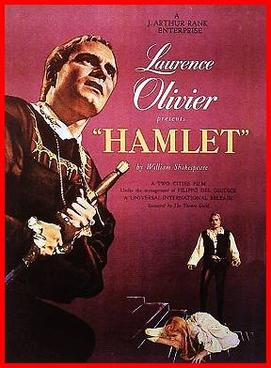
See pithy remarks for my personal comments.
Prince Hamlet gives one of the most famous soliloquies in literature in Act 3, Scene 1 of Shakespeare’s Hamlet. He enters and speaks to himself and the audience, supposedly unaware that Claudius and Polonius are spying on him. The soliloquy performed by Laurence Olivier in the 1948 adaptation is perhaps the best portrayal of Hamlet’s speech. Olivier’s subtle depictions of Hamlet’s character and the imagery surrounding him combine to give life to Shakespeare’s words.
Produced before the widespread use of color, the film is in black and white, giving the scene a more serious and grave tone. The audience first witnesses a vast grey ocean, full of white sloshing foam. As the camera pans down this “sea of troubles”(58), dramatic orchestral music is played, creating a tense feeling, a premonition or a “before the storm” aura. The sea’s waves crash onto a precipice, on which Olivier stands at the top, glancing at the bottom. Hamlet’s soliloquy implies suicide and death, fitting the scene of the movie, as Olivier delivers his lines perched on the precipice. As if being controlled by his character’s maddening subconscious, Olivier expresses the well-known “To be, or not to be, that is the question”(55) while blurred vision of the bottom of the precipice is shown. The line basically states whether one should live or not, alluding to this Hamlet’s consideration of jumping off the cliff. Olivier speaks clearly and slowly, as if speaking to the gods as they twist the restless sea and sky. He pulls out a dagger accordingly as he suggests that life and its troubles should be ended once and for all: “to take arms against a sea of troubles / and, by opposing, end them”(58-59).
While haphazardly wielding the dagger, Olivier closes his eyes, letting his mouth close and his mind speak of, coincidentally, sleep and death. The music heightens as the camera zooms into him. The audience hears him proclaim “to die, to sleep / to sleep…”(63-64), and suspense builds as the audience might expect him to suddenly stab himself. However, he stirs and speaks again, lamenting that “for in that sleep of death what dreams may come”(65). Through Olivier’s interpretation, Hamlet contemplates the consequences of death, and consequently, Olivier lowers the dagger. When Hamlet lists the “whips and scorns of time”(69), Olivier seemingly looks away on purpose as he mentions “the pangs of despis’d love”(71). Hamlet may be referring to unreciprocated love, specifically of his relationship with Ophelia. He looks away and pauses, probably in frustration over Ophelia’s shunning him. Hamlet returns back to the subject of ending one’s life, as he utters “when he himself might his quietus make / with a bare bodkin”(74-75). Olivier aptly raises the dagger and tightens his grip on it. He then continues, commenting the “undiscover’d country”(78) of the afterlife, where “no traveler returns, puzzles the will”(79). At this point, Olivier props himself up, and stares inquisitively at the distant sky and sea.
After dropping the dagger into the sea, Olivier appears more confident, fitting in with Hamlet’s “thus conscience does make cowards of us all / and thus the native hue of resolution / is sicklied o’er with the pale cast of thought”(82-84). Hamlet seems to imply that his excessive thoughts of death have interfered with his boldness. Ready to face whatever comes next, Olivier stands up, walks to the edge of the precipice to deliver “and enterprises of great pitch and moment”, hinting at the momentous actions to be carried out at the climax of Hamlet’s situation. Incidentally, a pitch means loftiness, “a term from falconry, signifying the highest point of a hawk’s flight”(pg. 82). Hamlet ends his peak of passion on the high precipice with “with this regard their currents turn awry”(86). Not wanting to let his plans fall through, Hamlet intends on finally executing his plot for revenge, and as Olivier turns around and exits, perhaps Hamlet will make a comeback and turnaround to cure his madness with his scheme. Olivier’s slow gait is ironic though, as Hamlet does not want to “lose the name of action”(86), foreshadowing a mishap in Hamlet’s plans.
With such emotion in his words and smooth gestures and actions, Laurence Olivier out performs the other Hamlets in delivering this prominent soliloquy. Despite being over half a century old, this representation of Shakespeare’s play accurately portrays the raw feelings of Hamlet and his situation, at least in this scene, making it the best out of the three films.
Monday, March 10, 2008
Hamlet Act 3, Scene 1 Video Critique
>>
10:44:00 PM
Labels:
Blog Writing,
Portfolio

Subscribe to:
Post Comments (Atom)
1 comment:
Another explication based on art and media. Apparently, for me at least, it is much easier to explicate when you have multimedia to aid you, even if it's just an image. An enjoyable assignment.
Post a Comment